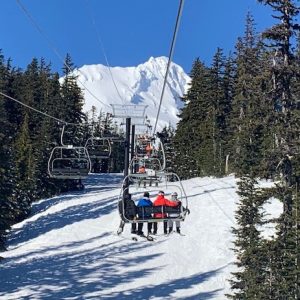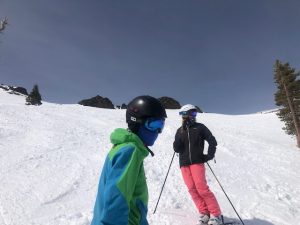
If you are like me and hate to waste hard-earned money, here are some of my hacks for making skiing affordable. The truth is that skiing fifty days a year can easily be less expensive than a single one-week ski vacation. It’s all in your approach – read on!
Skiing can be an expensive sport, with lift ticket prices skyrocketing in recent years. Take, for example, the case of Arizona Snowbowl in Flagstaff, which, thanks to “dynamic pricing,” broke the $300 daily lift ticket barrier in January 2023, reaching a record-breaking $309. This is a significant increase considering that just four years ago, Vail broke the $200 mark, and only nine years ago, the $100 threshold was surpassed. These rising prices are out of sync with inflation, which justifies a ticket price of $152. More than ever, skiing is perceived as a luxury few can afford. But skiing doesn’t have to break the bank! With affordable Epic, Ikon, Indy, and/or Mountain Collective Passes, astute skiers who purchase season passes in advance of the ski season have never skied more, sampled a greater variety of resorts, or paid less per day; these passes have revolutionized the skiing experience, providing opportunities for both frequent and occasional skiers to affordably enjoy a wide variety of ski mountains.
To make next season’s skiing adventures more budget-friendly, here are 16 valuable tips and hacks so you can ski more for less.
1) Never pay full price for lift tickets. Never! If you have to buy your ticket at the window, you have lost the game! You can always purchase less expensive tickets in advance on the resort website. The earlier you buy, the better the price. Also, some ski shops or grocery stores enroute to the mountain offer discounted tickets.
2) Invest in a Season Pass: If you live close to a ski resort, buy a season pass in the spring for the upcoming season. This often grants you free skiing for the remainder of the current season. Additionally, if your local area is part of the Powder Alliance, you’ll receive three free days at 22 other member ski areas.
3) If you plan to ski for several days next season, consider investing in a multi-resort pass like the Epic (41 resorts), Ikon (49 resorts), Mountain Collective (two days each at 16 resorts) and/or the Indy Pass 2 days each at 120 + resorts). Especially if you purchase these passes in the spring, your payback can be as short as four or five ski days for Epic and Ikon and three days for Mountain Collective or Indy. It’s also more cost-effective to use your Ikon or Epic at your ski resort of choice for an annual ski vacation than to buy a multi-day pass at a mountain. Plus, the variety of areas offered by a multi-area pass allows you to book your vacation in regions that have received the most snowfall if you are willing to hold your decision to the last minute. It also makes a spontaneous trip to catch a big dump more affordable since your ski tickets are prepaid!
4) Pre-Buy Lift Tickets: Many ski areas offer the option to pre-buy a block of lift tickets (usually four) early in the season at a deeply discounted price. Take advantage of these offers as they are often transferable. Epic Pass resorts, for example, allow you to pre-buy one to seven lift tickets at rates as low as $88/day and receive 20% off food and other purchases.
5) Buddy Up: If you have friends who own an Ikon or Epic Pass, they can “hook you up” with a limited number of buddy passes. These passes offer significant discounts, ranging from 25% to 40% off the window rate.

6) Take advantage of specific pass options like the Ski Cooper Pass, which allows you to ski three days each at 22 other resorts for just $379, making it a great investment even if you don’t take advantage of unlimited skiing at Cooper itself.
7) Explore other affordable season pass options that offer free days at other mountains. As an example, purchase a pass in December at little known Mount Bohemia in Michigan’s Upper Peninsula for $109, and you can enjoy one to three free days at nearly twenty different ski areas and never even ski Mount Bohemia.
8) Sign up your third to sixth grade children for state specific ski passport programs like the 4th -6th grade Utah Passport ($69), Colorado 3rd – 6th grade Ski Country Kids Passport ($59), Idaho 5th and 6th grade Passport ($18), Vermont‘s 5th grade passport ($20). or New Hampshire 4th and 5th grade Passport ($59). These programs allow kids to ski between one and four days each at participating ski areas, regardless of their state of residence.

9) Consider buying used ski gear instead of new. Websites like GearTrade and SidelineSwap offer used equipment at affordable prices. Many retailers like REI, EVO, and Patagonia also have sections of their websites dedicated to used gear. Ski swaps and second-hand outdoor gear shops near ski towns are also worth exploring. Purchasing used gear is better for the environment and your wallet.
10) Time new gear purchases strategically. Buy new gear at the end of the previous skiing season especially for brands where manufacturers are making significant model or cosmetic changes, resulting in better pricing. Buying used demo skis at the end of the season can save as you get bindings and skis together and they are premounted, saving the mounting fee.
11) Early April is an excellent time for a ski vacation. The days are longer and warmer, there are often surprise powder days, and mountains usually have the deepest base of the season with non-existent crowds. Some resorts offer discounted Spring Passes that can be paid off with as few as two visits. Note: Don’t try this in North Carolina or West Virginia!
12) Pack your own snacks and avoid expensive ski area cafeterias or, worse, sit-down restaurants! Bring energy bars or trail mix, eat a hearty breakfast, and ski through lunch, only stopping for water and rest breaks.
13) Consider tailgating instead of expensive bar drinks for Après Ski. Bring folding chairs and a cooler and hang out in the parking lot! While this doesn’t really work on cold, snowy days –the parking lot can be more fun than the bar on warm spring days! A- Basin even takes parking reservations in spring for “The Beach,” their snowside parking spots, perfect for tailgating.
14) Travel with a ski club. Many major cities have ski and snowboard clubs that offer group trips at negotiated rates, making them more cost-effective than solo trips.
15) Explore lesser known mountains that offer fantastic terrain and often have smaller crowds and much lower ticket prices. Consider destinations like Brundage, Jay Peak, Cannon, Powder Mountain, Loveland, and 49 Degrees North. These mountains often belong to the Indy Pass or Powder Alliance, providing affordable access.
16) Opt for affordable accommodations. Instead of expensive slope-side hotel rooms, consider staying in an Airbnb a few miles from the mountain. Sharing accommodation with another family can help reduce costs. A kitchen allows you to prepare meals instead of dining out. If you are willing to play chicken, you can sometimes bargain with an Airbnb host and get a last-minute booking discount.
Start planning early and save money for the slopes next season! As we swelter in the summer months, who knows what the long-range future will be for skiing. It only makes sense to ski now while we still can, and it never hurts to save money in the process.
John R Dockendorf wrote his master’s thesis on differential pricing in the ski industry in 1992, when ticket prices averaged about fifty dollars. An avid skier and ski writer, he commits to skiing the 60-plus days each year needed to match his age! He has skied at over 100 mountains in the US, from North Carolina to West Virginia to Utah, New England, and Tahoe – you can still find him skiing bumps and trees in his advanced old age. When not skiing, he is a business consultant based in Hendersonville, NC, and Hood River, OR.